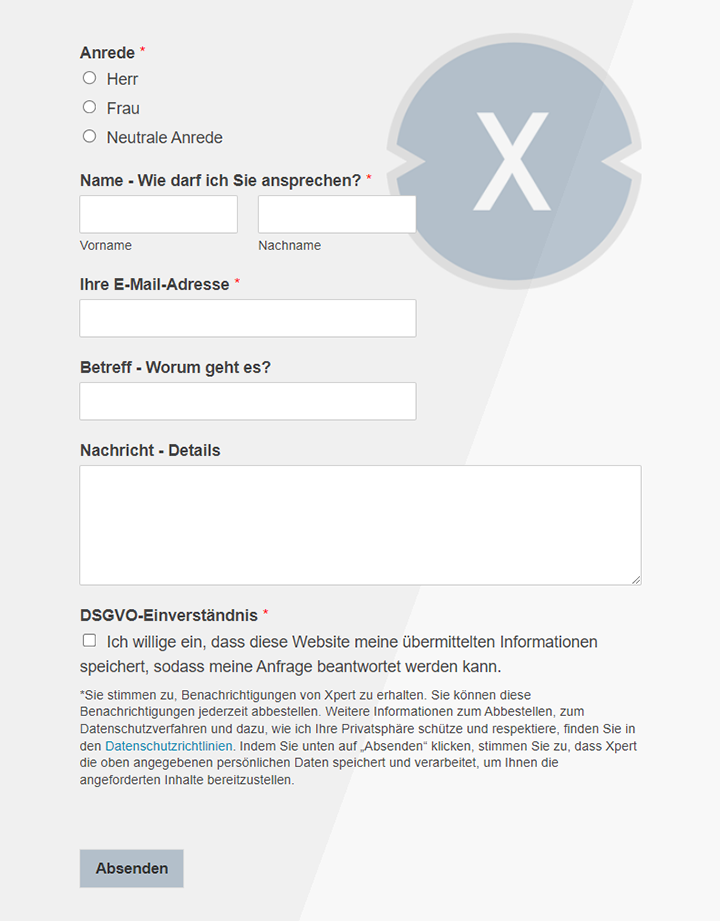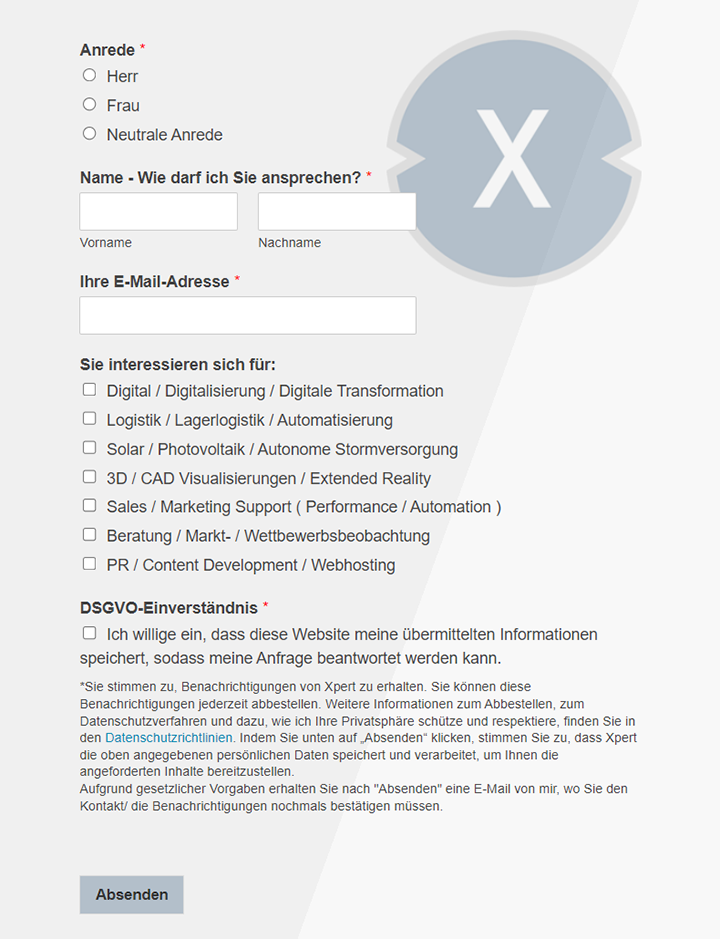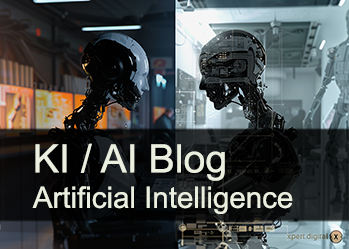Europe's AI ambitions in global competition: a comprehensive analysis-digital colony or does the breakthrough come?
Xpert pre-release
Language selection 📢
Published on: April 10, 2025 / update from: April 10, 2025 - Author: Konrad Wolfenstein

Europe's AI ambitions in global competition: a comprehensive analysis-digital colony or does the breakthrough come?
How the EU wants to become a worldwide frontrunner in artificial intelligence
Artificial intelligence: Can the EU keep up with the USA and China?
The European Union (EU) has set itself an ambitious goal: it wants to take on a global leadership role in the field of artificial intelligence (AI). The focus should be on trustworthy and human -centered AI. This goal is based on the strengths of Europe: an excellent research landscape and a strong commitment to ethical values. The EU strives to achieve technological sovereignty and at the same time optimally use the economic potential of AI.
However, reality looks more complex. Europe is struggling with structural challenges that significantly affect its competitiveness in the global AI race with the USA and China. These challenges concern various aspects, from the fragmentation of the digital internal market to difficulties in the commercialization of research results.
Suitable for:
- Trusty AI: Europe's trump card and the chance of taking on a leading role in artificial intelligence
The central challenges at an overview
Fragmentation of the digital internal market
Different national regulations, standards, data access rules and language barriers make AI companies difficult to grow across Europe and to achieve scale effects.
The “European paradox”
The discrepancy between excellent research and slow implementation into marketable products is particularly clear in the AI sector.
Financing gap
Compared to the USA and China, there is a significant gap in risk capital financing, especially in later growth phases of AI start-ups.
Lack of coordination
The coordination between the EU level and the Member States has so far been often ineffective, shaped by fragmented national approaches and inadequate governance structures.
Regulatory challenges
Initiatives such as the AI Act aim to address problems through harmonization and improved data availability. However, there are concerns about possible obstacles to innovation and high compliance costs, especially for small and medium-sized companies (SMEs) and start-ups.
Talent migration
Europe loses highly qualified AI specialists to the United States and other regions, which further weakens innovative strength.
The starting point: ambition and reality
The European Union has confirmed its goal in numerous strategy papers and initiatives to play a leading role in the development and application of AI. The strategy aims to make Europe a global center for trustworthy and human -centered AI.
This vision is based on the assumption that Europe's strengths - an excellent research landscape and a strong commitment to ethical principles - can serve as a foundation for success. Strategies such as the “European approach to artificial intelligence” formulate clear goals to strengthen research and industrial capacities and to promote the introduction of AI.
However, reality looks different. Europe is faced with considerable challenges that endanger its competitiveness in the global AI market. One of the biggest challenges is the massive gap in risk capital investments compared to the USA and China. This shortage of capital hinders the scaling of promising AI start-ups.
In addition, there is the continued fragmentation of the digital internal market, which makes it difficult to offer their solutions quickly and efficiently across national borders. This leads to higher costs and longer market introduction times, which affects the competitiveness of European AI companies.
The European paradox in the AI sector
Europe has long been struggling with the so -called “European paradox”: the difficulty of implementing its strength in basic research and scientific publication activity into commercially successful products, services and market leaders. This phenomenon still seems to be exacerbated in the area of AI, a technology that depends particularly strongly on fast growth, large amounts of data and considerable capital investments.
The structural weaknesses of Europe-the lack of risk capital, fragmented markets and slow commercialization-have a particularly disadvantage in the AI sector. Global competitors such as the USA and China have ecosystems that better meet the requirements of AI development with huge inland markets, solid risk capital and dominant technology platforms.
The fragmentation of the digital internal market: an obstacle to scaling
The dream of a uniform digital internal market in the European Union is still far from reality for AI companies that want to expand across Europe. Instead of a homogeneous market, Europe often resembles a “patchwork” on which each country pursues its own rules and priorities in the digital area. This fragmentation represents a significant hurdle for the scaling of AI solutions and affects the competitiveness of European companies in global comparison.
The causes of this fragmentation are varied and profound:
Regulatory divergence
Although EU-wide legislation such as the General Data Protection Regulation (GDPR) exist, their different interpretation and enforcement by the 27 national authorities lead to considerable legal uncertainty and complexity for companies. Even recent harmonization efforts such as the Digital Markets Act (DMA) provide the risk of strengthening fragmentation rather than reducing the fragmentation by inconsistent enforcement. The AI Act, the central law to regulate AI, aims at complete harmonization in order to prevent precisely such national deviations. However, there are concerns that different national implementations, capacities of the supervisory authorities and possibly national specifications or interpretations could again lead to de facto fragmentation.
Missing standards
The lack of uniformly recognized technical standards for AI systems, data formats and interfaces in Europe hinders interoperability and makes it difficult for market access for new solutions. The AI Act recognizes this problem and relies on the development of harmonized standards by European standardization organizations. However, this process is time-consuming and carries the risk of delays and disagreements, which continues to slow down the rapid scaling of innovative AI applications.
Data access and use
AI models, especially in the area of mechanical learning, need access to large and diverse data sets for training and validation. Different national rules and practices in data access that go beyond the GDPR create hurdles. The GDPR itself also contains vague clauses, the use of which often requires an interpretation in the context of AI, which leads to uncertainties. Initiatives such as the Data Act and Data Governance Act should improve access and the common use of data, in particular industrial and IoT data. However, they also introduce new complex regulations, the practical effects of which remain to be waiting for the data availability for AI applications and that may create new compliance hurdles.
Language barriers
The linguistic diversity of Europe with 24 official languages is a special challenge for the development and scaling of AI applications, especially in the area of natural language processing (NLP) and in large language models (LLMS). The adaptation of models and services to different languages and cultural contexts is resource -intensive and significantly increases market entry costs.
National interests and “selfishness”
Instead of a coordinated European strategy, many Member States primarily pursue their own national AI agents and promote national champions. This leads to double work, inefficient resource allocation and prevents the bundling of forces that would be necessary to survive in global competition. The unequal distribution of AI competencies and resources within the EU exacerbates this problem.
More barriers
Classic internal market obstacles such as different VAT rates, geoblocking practices and complicated consumer protection regulations, which make cross-border digital business more difficult.
The direct consequences of these diverse fragmentation aspects for AI companies are serious: they increase the costs for the development, adaptation and marketing of AI solutions significantly, extend the time to market maturity (time-to-market) and make it extremely difficult to achieve the scale effects necessary for global competition. This in turn scares investors and weakens the attractiveness of the European market for ambitious AI start-ups.
Suitable for:
- AI Action Summit in Paris: Awakening of the European Strategy for AI - “Stargate Ki Europa” also for startups?
The slow commercialization of EU-KI research
A central obstacle to Europe's competitiveness in the AI area is the continuing difficulty to convert the results of its strong research base into marketable products and services. This phenomenon known as “European paradox”-the gap between scientific excellence and commercial success-is particularly pronounced in the AI sector. While Europe was or is leading for a long time in scientific publications in the AI area and has first-class research institutions, there is a lack of implementation of this strength into globally competitive AI companies.
The reasons for this slow commercialization are complex:
The risk capital gap
One main factor is the dramatic lack of risk capital (venture capital, VC) for AI start-ups in Europe compared to the USA and China. This dominance of the United States, especially for large financing rounds for basic models, continues. This lack of sufficient capital, especially for the capital-intensive scaling phase (“scale-up”), prevents promising European AI companies from growth, forces it to search for financing outside the EU (which can lead to emigration) and makes it unattractive for investors.
The gap between science and economy
Despite excellent research institutes, the transfer of scientific knowledge into industrial use is only slow. There is often a lack of established mechanisms and incentives to support commercialization after the initial research funding. In contrast, there are dynamic ecosystems in the USA, in which research results can quickly be transferred to start-ups and can be integrated as platforms and customers by large technology companies. Europe is lacking in a comparable density of large digital companies that could serve as such “starting stalks” for AI innovations.
Cultural and structural obstacles
A higher risk aversion in comparison to the USA shapes the behavior of investors, established companies and sometimes also regulatory authorities in Europe. This makes financing more ambitious, potentially disruptive ideas (“Moonshots”) and slows down the adaptation of new technologies. Entrepreneurial failure is more stigmatized than in the United States, which dampens the willingness to establish risky start-ups. Inconsistent strategies in dealing with intellectual property (IP) and a lack of tracking the use of results from EU-funded research projects hinder their commercial use. Small and medium -sized companies (SMEs) encounter special hurdles, such as financial bottlenecks and a lack of specialist knowledge, in the introduction and scaling of AI. The fragmentation of the markets and the regulatory load, especially through the AI Act, represent additional challenges.
The “Brain Drain” at AI talents
Another critical problem is the emigration of highly qualified AI specialists from Europe (“Brain Drain”). Talents trained in Europe leave the continent in search of better career opportunities, higher salaries and more attractive research and development environments, especially towards the USA. The main reasons for the emigration are higher salaries, more ambitious projects, better research conditions and ecosystems as well as lower bureaucratic hurdles. Although Europe may have a high density of AI experts per capita and many researchers train, it has difficulty keeping top forces (“Top-Tier”/“Elite” talents) in global competition. China catches up rapidly when it comes to training top talents. This loss of human capital directly undermines the innovation and commercialization ability of Europe.
Our recommendation: 🌍 Limitless reach 🔗 Networked 🌐 Multilingual 💪 Strong sales: 💡 Authentic with strategy 🚀 Innovation meets 🧠 Intuition
At a time when a company's digital presence determines its success, the challenge is how to make this presence authentic, individual and far-reaching. Xpert.Digital offers an innovative solution that positions itself as an intersection between an industry hub, a blog and a brand ambassador. It combines the advantages of communication and sales channels in a single platform and enables publication in 18 different languages. The cooperation with partner portals and the possibility of publishing articles on Google News and a press distribution list with around 8,000 journalists and readers maximize the reach and visibility of the content. This represents an essential factor in external sales & marketing (SMarketing).
More about it here:
Artificial intelligence and EU programs: Where do we really stand?
The effect of EU funding instruments for AI
The European Union uses a number of financing instruments to promote research, innovation and the use of artificial intelligence. The two most important programs in this context are HORIZONT Europe and the “Digital Europe” program (DEP). The EU has undertaken to significantly increase the publicly financed AI research and innovation. However, a more precise view of the programs and their previous effect reveals a mixed image and significant challenges.
The results of Horizont Europe in the AI area are ambivalent. Numerous projects are financed and a high level of participation is achieved, but the European Court of Auditors (ECA) explicitly criticizes the low patentation rate for specific AI projects under Horizont 2020 (the previous program). It is even more serious to find the ECA that there is a lack of a systematic tracking and support of the commercial exploitation of the research results.
The “Digital Europe” program (DEP) focuses on the introduction of digital technologies, the establishment of capacities and the financing of digital infrastructures. In the AI area, it finances central elements such as the AI access platform (“Ai-on-Demand Platform”), European data rooms, test and experiment facilities (TEFS) and the European digital innovation centers (EDIHS). However, the implementation of these infrastructure projects was slow according to ECA. Some facilities were put into operation late or were not yet fully functional at the time of the examination.
The European Innovation Council (EIC) Accelerator is specially designed to promote risky but potentially groundbreaking innovations of SMEs and start-ups. However, the program is extremely competitive. Although the EIC also financed AI companies, the ECA found that the instrument was insufficiently geared towards groundbreaking AI innovators and offered no capital support for larger scale-up companies.
The special report of the ECA provides a critical overall assessment of the EU measures to promote a AI ecosystem: coordination deficiencies, delayed infrastructure, inadequate leverage, lack of monitoring and lack of commercialization.
Suitable for:
- AI model Openeurollm: Europe's AI secret weapon revealed-the exciting answer to Chatgpt and Deepseek
Coordination between the EU and Member States: On the way to a uniform AI strategy?
Effective coordination between the EU level and the individual Member States is crucial for the success of a European AI strategy. Resources can only be bundled through joint action, fragmentation can be avoided and a critical mass can be achieved in order to survive in global competition. However, the previous coordination mechanisms have proven to be inadequate.
Before the introduction of the AI Act, the coordination was mainly based on the “coordinated plans for AI”. However, the analysis has uncovered significant defects in this coordination: limited effectiveness, inadequate governance instruments, outdated goals and lack of liability, lack of monitoring and national fragmentation.
The AI Act establishes a new, more comprehensive governance framework that is supposed to fix these weaknesses and enable more cargo control of AI policy in the EU: European AI Office (AI office), European AI Board (AI Committee) and national responsible authorities.
This new structure has the potential to significantly improve coordination by creating clear responsibilities at the EU level and establishing a central forum for exchange and coordination between the Member States. However, the success of this new governance structure depends crucially on the active participation and commitment of the Member States as well as the sufficient resource equipment at the national level.
The EU policy instrument: Analysis of central regulations and programs
In recent years, the European Union has developed a comprehensive instrument of regulations and funding programs to shape the AI sector, promote innovation and at the same time manage risks. The most important elements are the AI Act, the data strategy (especially Data Governance Act and Data Act) as well as the funding programs HORIZONT Europe and digital Europe.
The AI Act is the world's first comprehensive law to regulate AI. His main goal is to create a harmonized legal framework that promotes innovation in trustworthy AI and at the same time protects the fundamental rights, health and security of the citizens. By creating uniform rules, the AI Act is intended to prevent the emergence of diverging national regulations and thus ensure a functioning internal market for AI technologies. However, start-ups and risk capital providers in particular express considerable concerns. They fear that the strict requirements cause high compliance costs, increase technical and organizational complexity and ultimately slow the innovation and reduce the competitiveness of European AI companies.
The density of the European regulatory network in the digital and AI area is unprecedented. Every law pursues legitimate goals, but in their entirety they could create cumulative compliance barriers, which in particular affect SMEs and start-ups. These companies only have limited resources to find their way around this complex, overlapping regulatory landscape.
Suitable for this:
The global AI race: Europe compared to the USA and China
In order to realistically assess the challenges and opportunities for the EU in the AI area, a comparison with the globally leading regions-the United States and China-is essential. This comparison reveals significant differences in investments, research, talent, market size and political approaches.
As already mentioned, there is a massive gap in the risk capital investments in AI between the EU and the USA/China. The United States dominates the market, especially through billions in investments in developers of basic models. China is also clearly ahead of the EU. This financing superiority enables American and Chinese companies to invest more aggressive in research, development, talent pacification and market development.
While the EU traditionally has a strong basis in scientific research and has high numbers of publication, China has now overtaken the EU in the pure number of AI publications. The United States continues to lead to the average quality and citation frequency of research, although China has also caught up here and partially took the lead with the papers. A clear weak point of the EU is the implementation of research into patented innovations.
The global competition for AI talents is intense. The United States is still the most attractive place of work for top AI researchers worldwide, even if its attractiveness has recently decreased slightly. However, they are increasingly dependent on the immigration of talents, also from China and Europe. This underlines the urgency for Europe to create more attractive conditions for AI experts in order to stop the “Brain Drain” and to secure one's own innovative strength. Targeted measures are required to attract both highly qualified specialists from abroad and to keep European talents in their own country.
China is massively investing in the training of its own AI experts and rapidly increases its share in global talent production. The EU trains many AI specialists and has a high density of experts, but struggles with a significant emigration (“Brain Drain”) from top forces to the USA.
The USA and China benefit from huge, largely homogeneous internal markets that enable quick scaling of technologies and business models. In contrast, the EU market is very fragmented. China also leads to the adaptation rate of AI technologies in the economy, while the introduction in the EU, especially at SMEs, is slower.
The three regions pursue different strategies. The EU relies on a value -based, regulatory -centered approach (“Trustworthy Ai”), which is embodied by the AI Act and is intended to ensure high ethical standards and security. The United States traditionally pursues a more market -driven, more innovation -friendly approach with less comprehensive regulation, even if individual authorities develop specific guidelines. China massively promotes AI as a strategic technology through government investments and initiatives, benefits from easier access to large amounts of data and relies on centrally controlled development.
A decisive factor in the global AI race is the dominance of the large technology groups from the USA (Google/Alphabet, Amazon, Facebook/Meta, Apple, Microsoft-often referred to as Gafa or Big Tech) and China (Baidu, Alibaba, Tencent, Xiaomi-Batx). These companies have immense resources: huge amounts of data from their platform services, leading cloud infrastructures, enormous capital and a global range. These assets give you a decisive advantage in the development, training and scaling of AI models and applications. You can attract top talents and buy potential competitors through acquisitions.
For European AI companies, this dominance represents an enormous competitive challenge. There is a risk that Europe becomes technologically dependent and degraded into a “digital colony” of these corporations. Regulations such as the Digital Markets Act (DMA) aim to limit the market power of these “gatekeepers”, but their effectiveness in the dynamic AI market is still controversial.
The strategic orientation of the EU on “trustworthy AI” as a differentiation feature is a risky undertaking in view of the global market dynamics. This strategy focuses on regulating (the AI Act) creating trust and possibly generating a market preference for European AI solutions. However, the global AI market is currently dominated by performance, scalability (especially for basic models) and speed of the introduction-areas in which US and Chinese giants are superior due to their data, capital and market advantages.
Navigation in the European AI ecosystem: Case studies of companies
The abstract challenges of market fragmentation, the financing gap and regulatory complexity manifest themselves in the daily reality of European AI companies. The examination of specific cases helps to understand how companies deal with these conditions, which strategies they pursue and which success factors are decisive.
Case study 1: Mistral Ai (France)
Mistral Ai quickly developed into one of the best -known European developers of large voice models (LLMS) and is often acted as a potential European champion. The company, based in Paris, is heavily relating to open source models as a differentiation feature. It was able to complete significant financing rounds, although the ratings are still significantly below that of the leading American competitors. Mistral pursues strategic partnerships, including SAP and Microsoft, as well as with other European AI specialists such as Helsing in the defense area.
Case study 2: Aleph Alpha (Germany)
Alph Alpha is another important European actor in the area of LLMS, who focuses particularly on the topics of sovereignty, explanability and trustworthiness of AI. The German company is supported by important industrial companies such as the Schwarz Group (owner of Lidl and Kaufland) and SAP.
Case study 3: Helsing (Germany-Defense Ki)
Helsing specializes in the development of AI applications for the defense and security sector. The company has closed a strategic partnership with Mistral Ai to jointly develop skills such as Vision-Language-Action models for this area.
In addition to these individual cases, general patterns for AI start-ups in Europe show:
challenges
The lack of risk capital, especially in later phases (late days), and the risk aversion of investors remain central hurdles. Many deep tech start-ups find it difficult to convincingly communicate the value of their technology. The scaling across the fragmented European markets is complex, and the regulatory load, in particular by the AI Act, is perceived as a significant obstacle.
Success factors
A strong start -up team with commitment and relevant expertise is crucial. The identification of a clear market requirement, the development of a robust technical solution and a well thought-out business and marketing strategy are just as important. Strategic partnerships, clear niche focus and effective process management for scaling also contribute to success. Some companies also try to proactively use the compliance with EU rules as a quality and trust feature.
The analysis of these cases and general trends suggests that European AI start-ups are often forced to pursue specific strategies in view of the disadvantages in capital, market size and uniformity compared to US and Chinese competitors. Successful companies focus on areas beyond the pure competition for generic LLMs. Partnerships with established industry or other start-ups play an important role.
Suitable for:
Course determination: Strategic recommendations for competitive European AI future
The analysis has shown that despite its strengths in research and talent development, Europe faces considerable challenges to realize its ambitions in the global AI race. The fragmentation of the internal market, the gap in the commercialization of research, deficits in the coordination, the emigration of talents and an inadequate financing landscape together affect the economic competitiveness and strategic autonomy of the EU in this critical technology sector. The risk of further falling behind the United States and China is real. In order to change the course and to raise the potential of Europe, determined and coordinated measures are required at all levels.
Recommendations for action:
For EU politicians
- Deepening of the digital internal market for AI
- Balance between regulation and innovation promotion
- Realignment of the funding strategy
- Expansion of the AI infrastructure
- Strategic public procurement
For the Member States
- Coordinate national strategies
- Strengthen national authorities
- Promote national ecosystems
For industry and investors
- Mobilize more risk capital
- Intensify cooperation
- Take strategic risk
For research institutions
- Strengthen commercialization focus
- Adjust training
Europe's AI potential: How a strong focus on innovation can drive global competition
Europe has considerable strengths - a broad research base, valuable industrial data, a large talent pool and an established ethical framework. In order to be able to realize his AI ambitions and exist in global competition, however, a concerted, coordinated and much more aggressive effort in politics, financing and culture is required. The focus must be postponed: from the pure regulation of AI to the active structure of a dynamic and globally competitive European AI ecosystem. This is the only way to bridge the gap between the existing potential and the market.
We are there for you - advice - planning - implementation - project management
☑️ SME support in strategy, consulting, planning and implementation
☑️ Creation or realignment of the digital strategy and digitalization
☑️ Expansion and optimization of international sales processes
☑️ Global & Digital B2B trading platforms
☑️ Pioneer Business Development
I would be happy to serve as your personal advisor.
You can contact me by filling out the contact form below or simply call me on +49 89 89 674 804 (Munich) .
I'm looking forward to our joint project.
Xpert.Digital - Konrad Wolfenstein
Xpert.Digital is a hub for industry with a focus on digitalization, mechanical engineering, logistics/intralogistics and photovoltaics.
With our 360° business development solution, we support well-known companies from new business to after sales.
Market intelligence, smarketing, marketing automation, content development, PR, mail campaigns, personalized social media and lead nurturing are part of our digital tools.
You can find out more at: www.xpert.digital - www.xpert.solar - www.xpert.plus
































